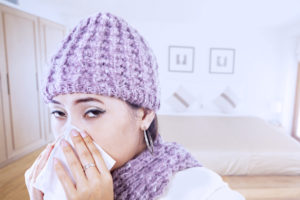December 09, 2016 | Black & Kletz Allergy

It is noteworthy to mention that all of the above allergens are found only indoors, except molds and occasionally pets. When the leaves fall from the trees in the Fall and get wet, molds will grow on the decaying leaves. In the Washington, DC metro area, the leaf mold is a major allergen that causes a great deal of suffering for many allergy patients. When the leaves are disturbed by either raking them, rainfall, or via the wind, the mold spores are more likely to become airborne, thus increasing the likelihood of them causing allergy symptoms in individuals with mold sensitivities. It is therefore recommended that a person with mold allergies should avoid exposure to leaves, particularly if they are or have been wet. They should also keep the humidity of their homes below 35%, if possible as there is direct correlation with increased humidity and the amount of mold growth. In the home, mold growth tends to be more abundant in basements, bathrooms, and kitchens due to the increased moisture found in these places.
The main culprits of dust allergy are the dust mites prevalent in the Washington, DC metropolitan area. There are 2 very common species of dust mites in the Washington, DC, Northern Virgina, and Maryland metro area. They are known as Dermatophagoides fariniae (i.e., American dust mite) and Dermatophagoides pteronyssinus (i.e., European dust mite). Both species are highly allergenic and tend to live indoors in places like carpeting, upholstered furniture, pillows, mattresses, box springs, and bedding. It is technically the fecal particles and exoskeleton that are the allergenic components of the dust mites. The dust mites are microscopic and look similar to a cockroach, however, they cannot be seen with the naked eye. They are about 0.25 mm. in length. They survive by eating dead skin that regularly sloughs off of humans each night. The dust mites thrive in warm moist climates and when the humidity is high. They do not survive if the temperature is over 130° F or when the altitude is greater than 1 mile (5,280 feet). Dust mites are known to be a cause of allergic rhinitis and asthma in many individuals. There are products that can be put on carpeting that act to kill dust mites, but these products have been shown not to very effective. Encasing one’s pillows, mattresses, and box springs in allergy-proof encasings are a fairly effective way to minimize exposure to dust mites.
When the home is “closed up,” pet allergens from the dander and saliva tend to be worse. Usually, however, pet allergy tends to be very similar for most individuals despite the time off the year. Likewise cockroach allergy is common particularly in major cities such as Washington, DC. Many homes, apartments, condos, restaurants, and public buildings in urban settings are infested with cockroaches, even though they may not be visible during the day to most people. It is important to make sure that traces of food are not left on counters, floors, etc., as this attracts cockroaches. There is a common strong association between cockroach allergy and childhood asthma in inner city populations. Cockroaches are potent allergens allergy sufferers of all ages and cause both allergic rhinitis and asthma symptoms.
Other than avoidance, which is always preferable, there are numerous medications that can be used by allergists to treat dust mite, mold, pet, and cockroach allergies. Allergy shots (i.e., allergy injections, allergy immunotherapy, allergy desensitization) are a very effective tool that board certified allergists use to treat individuals with these allergies, as well as pollen allergies. They work in 80-85% of people and allergy injections have been used in the U.S. for over 100 years. The average length of treatment is 3-5 years.
The board certified allergists at Black & Kletz Allergy have been diagnosing and treating allergies and asthma for more than 50 years in the Washington, DC, Northern Virginia, and Maryland metropolitan area. We have convenient locations in Washington, DC, McLean, VA (Tysons Corner, VA), and Manassas, VA. Each office has on-site parking. The Washington, DC and McLean, VA offices are Metro accessible and there is a free shuttle that runs between our McLean, VA office and the Spring Hill metro station on the silver line. Please call for an appointment if you would like a consultation with one of our allergists, or alternatively, you can click Request an Appointment and we will respond within 24 hours by the next business day. Black & Kletz Allergy prides itself in providing quality allergy and asthma care to the Washington, DC, Northern Virginia, and Maryland metropolitan area community.












